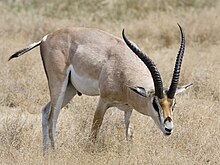Grant's gazelle
| Grant's gazelle | |
|---|---|
 |
|
| Scientific classification | |
| Kingdom: | Animalia |
| Phylum: | Chordata |
| Class: | Mammalia |
| Order: | Artiodactyla |
| Family: | Bovidae |
| Subfamily: | Antilopinae |
| Genus: | Nanger |
| Species: | N. granti |
| Binomial name | |
|
Nanger granti (Brooke, 1872) |
|
The Grant's gazelle (Nanger granti) is a species of gazelle distributed from northern Tanzania to South Sudan and Ethiopia, and from the Kenyan coast to Lake Victoria. Its Swahili name is Swala Granti. It was named for a 19th-century Scottish explorer, Lt Col Grant.
Grant's gazelle is more genetically related to Soemmerring's gazelle (N. soemmerringii) and Thomson's gazelle (Eudorcas thomsonii) with Soemmering’s gazelle being the closest relative of the two species. Grant's gazelle shows high genetic variation among its populations, though there is no geographic isolation. The differentiation of the species may have evolved during repeated expansion and contraction of arid habitats during the late era in which populations were possibly isolated. Grant's gazelle was formerly considered a member of the genus Gazella within the subgenus Nanger before Nanger was elevated to genus status.
Listed alphabetically.
The Grant's gazelle stands 75–95 cm (30–37 in) at the shoulder. The females weigh from 35 to 50 kg (77 to 110 lb) and males from 50 to 80 kg (110 to 180 lb). Its coat is a beige orange on the back with a white belly. The Grant's gazelle looks similar to a Thomson's gazelle, except it is much larger and has lyre-shaped horns which are stout at the base, clearly ringed, and measuring 45–81 cm (18–32 in) long. The subspecies are segregated by different morphological characters, such as horn shape and slight differences in coat colour. These differences are not indicative of ecological separation as with some species. Grant's gazelles are extremely fast; they can run 80 km/h (50 mph), but larger males do not exceed 72 km/h (45 mph).
The Grant's gazelle is found in East Africa and lives in open grass plains and is frequently found in shrublands; it avoids areas with high grass where the visibility of predators is compromised. They also occur in semiarid areas and are relatively well adapted to dry areas, relying on more browse or leafy material during dry seasons to supplement their intake of water. They are migratory animals, but travel in the opposite direction of most of the other ungulates, such as Thomson's gazelles, zebras, and wildebeest, which are more water dependent. They can subsist on vegetation in waterless, semiarid areas, where they face little competition.
...
Wikipedia

